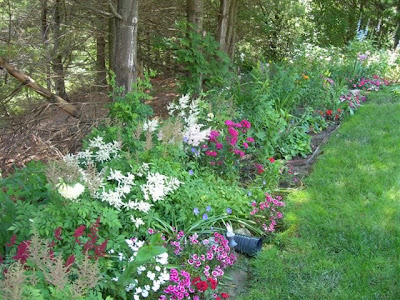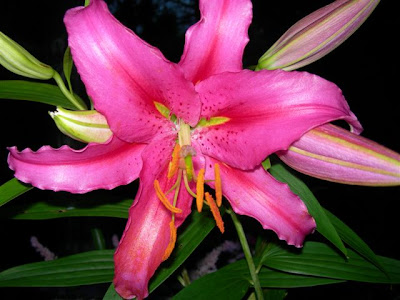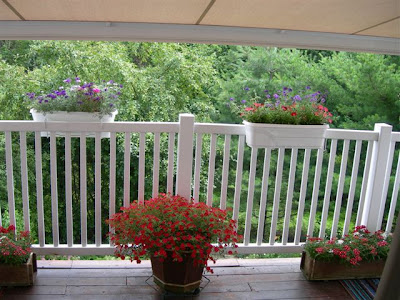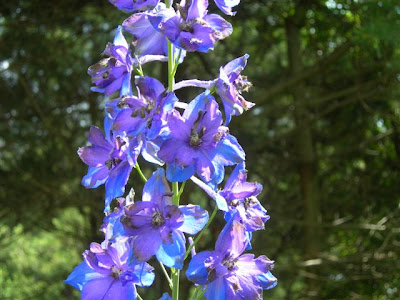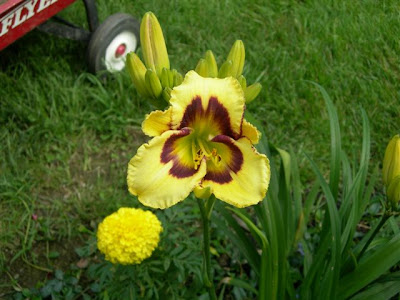Hello again,
Gardening is Happening in Skillin's Country!
In this post we will be letting you know what we are doing or what we hear is going on out there in our local gardening world.
We will be updating this post with quick supplements all through the week!
So check here frequently!
If you would like to contribute just drop us a quick note at
info@skillins.com OR leave a comment at the end of this post.
We would
LOVE any tips OR questions from you.
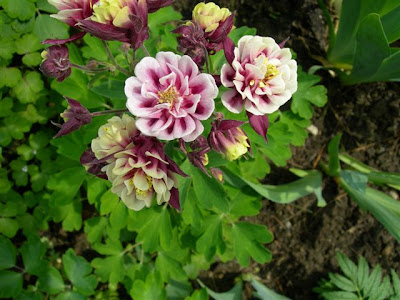
Greetings from to all of us from Barbara Gardener: "I have a lot of new columbine this year. I really liked this one because it was looking up and only 12 to 14 inches tall".
That picture symbolizes why we garden here in Maine! Lots of work but some great rewards!
Columbine is a wonderful old time perennial plant but as you can see from the picture above there are many new exciting varieties to choose from!
July 20:
Well, since late Friday we have received over an inch of rain into Skillin's Rain Gauge located in the heart of Skillin's Country; other areas in Skillin's Country may have received more than that.
Despite the wild weather that caused power outages, prehistoric sized hail and downed trees in some areas the rain was very welcome as I have noticed all my established plant material that was wilting from the dryness has now sprung back to life. That is a great thing!
However, we were so dry and much of that rain came so quickly I would suspect that our newly planted material will still need a good quality watering in the next day or so from your hose and watering can.
July 19:
I have some bare patches on some poor soil in my small back yard lawn. One of my gardening goals this year is to improve the soil and get some better lawn growing there. The soil improvement is coming and will continue to come from my faithful application of Organica's Four Step Lawn products (found at http://www.organica.net/ and talked about frequently by me here at the Skillin's Garden Log.)
I am always in a hurry and just the other day I simply cast some Black Beauty grass seed down on the bare patches, got my old sprinkler going and off I went! Well, after a few vigorous waterings from the old sprinkler I have noticed that my uncovered grass seed is being moved by the water into irregular piles. Rookie mistake!
To germinate and grow well, grass seed should be raked into the ground and then covered with a light covering of mulch. So today I am going to rake in that seed with a metal cultivator (like I should have in the first place) and then cover my seed with compressed paper pellets called Grass Seed Accelerator. I highly recommend this product as the compressed paper will expand once it becomes wet for the first time and then it will hold the seed in place during the required daily waterings from my old sprinkler.
Again for seeding in tough areas (and frankly in Maine between our challenging climate, ledge, clay or sandy mediums all lawn areas are tough areas) I would recommend the Black Beauty Grass Seed by Jonathan Green. It is the best combination of good appearance and toughness for our challenging gardening climate in Maine that I know of. Check out this link http://www.jonathangreen.com/blackbeauty.php for more details or better yet simply come over to Skillin's and check this excellent grass seed out!
July 18:
I had a customer bring in a classic example of tomato blossom end rot today. Blossom end rot shows up as dark sunken spots on the bottom ends of tomatoes, peppers, and squash. It's caused by a calcium imbalance in the plant -- the soil may have adequate calcium, but the plant isn't able to take up enough to supply the rapidly developing fruit.To minimize the problem, keep soil evenly moist, apply a layer of mulch to conserve moisture (the Fundy Mix by Coast of Maine is an excellent choice), don't overfertilize with high nitrogen fertilizer.
We do carry some excellent sources of liquid calcium which could quickly turn the calcium deficiency around. We recommend Rot Stop by Bonide or Flower Booster by Organica.
I have been fertilizing my vegetables with side dressings of Plant Booster Plus by Organica along with weekly liquid feedings of Fish/Seaweed fertilizer by Neptune's Harvest (lots of calcium there!). So far my tomatoes and the small fruit I have is looking just great!
July 17:
Paul Tukey pointed out to me this morning that we really should not be selling Sevin as it is not a planet friendly product and he claims it will be de-registered by the EPA within 5 years.
I agree with Paul in that Sevin is not my product of choice for pest problems in the garden. Between effective products like Neem (I love K Neem by Organcia), pyrethrins (Japanese Beetle Killer by Bonide is a hot product right now) and All Seasons Spray Oil (we sell an effective oil by Bonide) there are plenty of other choices out there!
Let us show you how to best Plant for the Planet!
July 16:
Terry Skillin our leader and garden guru checks in with this note he wrote to our staff just the other day. It hurts me to admit it but this is real good stuff:
Japanese Beetles as many have noticed are back with a vengeance. Those pretty metallic red beetles are eating everything and our gardening pals are having little patience for their rude behavior. They want them dead! There are several possible solutions that we can talk over with gardeners. Bayer Rose and Flower RTU is a great control for the little beasties. Beetle Traps, can work too well and because of this you need to stay on top of emptying the bags as soon as they fill. The traps use a floral and sex lure (sounds a little like Valentines Day) that attracts the beetles by the hundreds. It is best to place the trap away from the gardens that you need to protect so the spill over does not just end up feeding on the garden. Grub Beater by Bonide is an insecticide, repellant, and insect growth regulator, that uses a botanical component. I like growth regulators and not just because of what seems like a diabolical plan to get even, which does render some satisfaction but it is using some of what nature provides for control. Sevin or Carbaryl is a non selective chemical solution that has been around for years, that for a chemical is relatively safe and quite effective. Be careful of bees with this one. Bayer Tree and Shrub or Imidacloprid would kill these guys as well but remember like any systemic insecticide the little beasties have to eat the plant to be killed by the insecticide. Rotenone and Pyrethrins are both a good none selective organic insecticide. Like Sevin they are contact killers which means that they need to come in contact with the pest so that they can RIP. I use Pyrethrin (one nice version is Japanese Beetle Killer by Bonide) and get a quick kill however I need to stay on top of the population and repeat often. Milky Spore and other grub controls are really the first line of defense and soon the adult beetles will be laying a new generation of eggs in our lawns. So as the eggs hatch over the next 4 to 6 weeks we can get some great control this late summer and fall and help reduce the number of beetles next year.
Vegetable gardens--now that it is summer and mostly dry our vegetable gardens will need more attention from the garden hose. Morning watering is the best to help minimize fungus problems and will best help support the plant during the heat of the day. If gardeners have to water at night it certainly can be done but try to talk them into morning. I know if it rains at night there is nothing we can do about that but when it does it is infrequent. Night watering that occurs every night usually keep plants and fruit too wet too long.
`
Fertilizing also becomes important now that plants are in full development and creating fruit. Side dressing our vegetable garden is an old slang tern for applying fertilizer sparingly along the side of the plants. This should be done two to three times per season. (From Mike S: I am using the Plant Booster Plus by Organica for my vegetables and I absolutely LOVE the results. I am also liquid feeding every week with the Fish/Seaweed fertilizer by Neptune's Harvest to get added calcium into the soil!).
Color is king in the garden and there is still plenty to go around. Hydrangeas of all colors and sizes are starting to do their thing. From the different whites like Annabelle Hydrangea arborescens a great zone 3 to 9 plant 4 to 6’ tall or Hydrangea paniculata “Little Lamb” compact 4 to 6’ zone 4 to the blues like Hydrangea macrophylla “Endless Summer” and the red H. mac. “Lady in Red” zones 4 and 5 respectively. Each will be around 3 to 4’ tall and wide with Endless Summer maybe up to 5’ tall. Check them out with others in our nursery catalog! Our nursery catalog can be found online at http://www.skillins.com/.
Perennials like Coreopis “Moonbeam” and “Jethro Tull” providing great color zone 4 full sun and grow to about 18” tall and if you like yellow but need more height False Sunflower Heliopsis “Orange Sunflower and Summers Night grow to 3 to 4 feet tall and are hardy for zone 3 to 9. Pretty tough. Page 25 and 12 in our 2008 Perennial catalog.
Powdery Mildew is back in the garden showing up on plants like Phlox, Begonias and Lilacs. We recommend all natural garden sulfur or another exciting all natural product called Serenade is very effective against powdery mildew.
It is still not too late to begin a monthly spray program for roses, grapes, tomatos, phlox, lilacs, crab and fruit trees to combat powdery mildew and other leaf spots using an excellent natural program called Messenger. Check out this link from a past Skillin's Garden Log entry where we discuss the merits of Messenger. The link is found at Garden Happenings! Week of May 12
